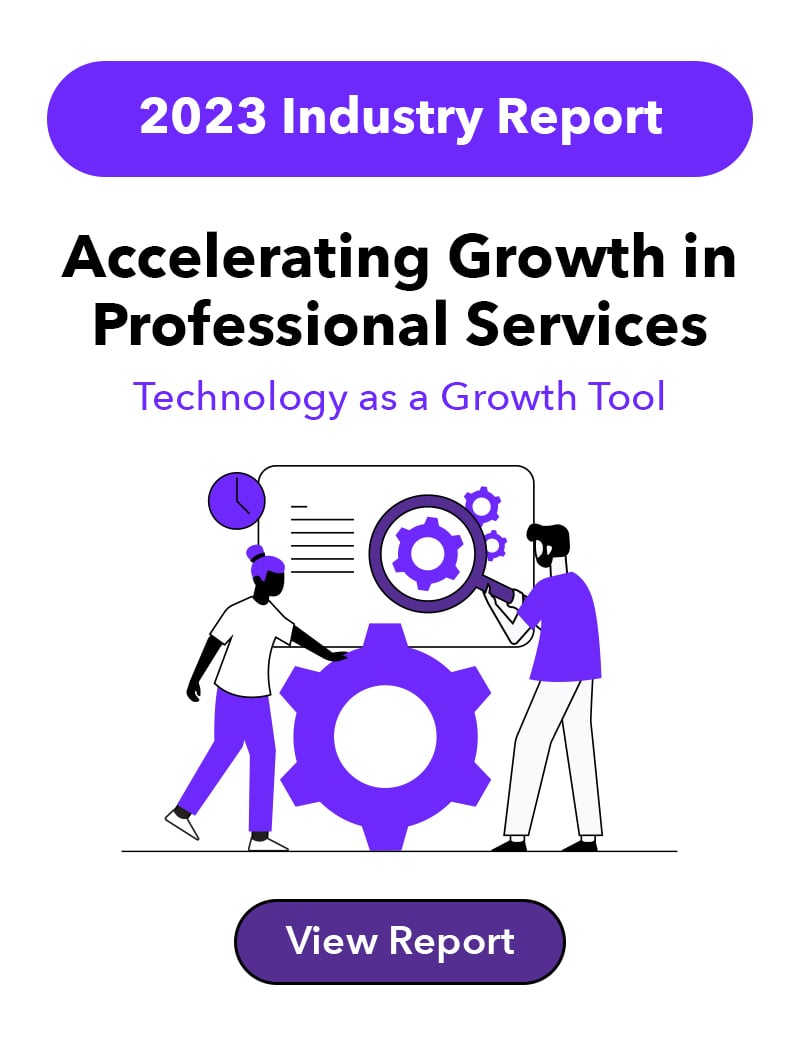Building an Effective Thought Leadership Strategy for Your Firm
Trust and proven expertise are some of the biggest strengths you can have on your side when it comes to landing new clients. People want to do business with firms whose knowledge they can rely on. If you can highlight the genius of the people on your team in a way that is helpful and tangible to your audience, you’re in the perfect position to gain them as a client.
This is the foundation of a thought leadership strategy.
While thought leadership content is highly valuable in every industry, it’s especially lucrative in the professional services industry. Many potential clients may seek out advice online before they search for services.
Having a strong thought leadership strategy gives you an opportunity to make a great first impression and puts you top of mind when they are ready to search for a firm to work with.
Case in point: According to a study by Edelman, over half of the decision-makers they surveyed said that they spend at least one hour per week consuming thought leadership content, and 55% said that they use this content as an important way to vet potential firms.
What Does a Thought Leadership Strategy Look Like for Professional Services Firms?
You may already have a content marketing strategy in place that nurtures potential clients throughout the whole funnel. Your thought leadership content will overlap a lot with this strategy, but it’s specifically targeting people at the top of the funnel by providing helpful content about the industry around you.
But the real value comes in when you add subject matter experts into the mix by putting an actual person behind the content.
Rather than publishing content under your firm’s name, you position your team members as the experts. This helps you not only bring in personal examples from the expert’s career, but it also back up what you’re saying with the expert’s accolades.
This is typically a multi-channel strategy that can spread across:
- Your blog
- Videos
- Social media channels
- Events
- And more
Thought Leadership is Your Chance at Differentiation
In our team’s conversations at industry events like Legal Marketing Association conferences, thought leadership strategies often come up as something that attendee’s teams are interested in. However, firms tend to prioritize other, more traditional marketing strategies since they are more proven.
Since, compared to other industries, professional services firms don’t typically have a strong thought leadership strategy, or don’t have one at all, this is a great opportunity for your firm to stand out.
Clients increasingly want to know what’s coming next, and they’re depending on established firms to provide that insight. If you can be the one to build a reputation for keeping your finger on the pulse, you will be miles ahead of your competition.
How to Develop a Thought Leadership Strategy
As a content marketer myself, I’ve had my hand in developing several thought leadership strategies, so I’ve picked up a few tricks along the way. Whether you have subject matter experts in your firm who are more than willing to help out or struggle to free up 30 minutes in their calendar, there are a few barriers that will inevitably come up.
But with these simple yet effective tips, you should have all of the tools you need to successfully launch this strategy. And most importantly, you should be on your way to increasing the positive contributions you make towards your firm’s growth.
1. Determine the subject matter experts in your firm
Like I said, the strongest thought leadership strategies lean on the experts in your firm. These individuals will help you to stay up-to-date on the latest developments, speak confidently about the topics you cover, and most importantly will humanize your firm.
So the first step is to uncover which experts you have in your firm, and who is available to invest time into this strategy. These individuals should have years of experience under their belt that they can speak from.
Some additional nice-to-haves (but not requirements) are a tendency to keep up with industry trends, an existing large following, a collaborative working style, and comfort with being on camera.
Where to find these experts
While an obvious area to look for these experts is in your pool of specialized service providers, i.e. your lawyers, accountants, bankers, etc, you may also bring in experts from other departments. If we use accounting as an example, someone in marketing may not have a direct hand in the accounting services, but they still have a unique perspective on their sector of the industry that is highly valuable.
The bigger the spread of expertise you have in your group of subject matter experts (SME’s), the better. For example, here at Pitchly, our SME’s range from marketing to client success to product development to the CEO.
2. Uncover their areas of expertise
Once you’ve identified your subject matter experts, work with them to make a list of the topics that they’re passionate and knowledgeable about. It’s okay to go deep and wide here. Brainstorm any topics that are broadly related to your target audience.
While an investment banker may have the most knowledge about the financial topics they advise their clients on, they may have additional expertise on topics like technology or productivity as it relates to your client base.
The main criteria for these topics is that the expert is knowledgeable enough to speak analytically about them. This requires a level of comfort and experience, rather than a hobby-level interest.
Once you map out the full list of their areas of expertise, see how this overlaps with the needs and considerations of your target audience. This will give you a plan for which topics to target in your thought leadership strategy, and which subject matter experts to approach to create content with about these topics.
3. Decide which platforms they will shine on
The easiest way to get buy-in from your team of subject matter experts is to give them an opportunity to do something they enjoy and that they’re good at.
Some team members may be especially outgoing. They are the perfect people to leverage in video content, on podcasts, and at speaking engagements.
Others may be extremely research-driven, or skilled writers. This group would be perfect to collaborate with on some really great written content.
Matching their involvement with their skill sets is going to create a much smoother process for both you and your experts.
Of course, there may still be times when you have to push your experts a bit out of their comfort zone, but balancing this with things they enjoy will make it more bearable.
Another important thing to note here is that repurposing will be your best friend. If one of your SME’s works with you to create an incredible video, you can transform that same content into blog or eBook content. Similarly, if you worked with someone to create effective written content, you can chop that up into social media posts.
4. Get widespread buy-in
The tip above is one great strategy to get buy-in for your thought leadership strategy. But some teams may take a little more convincing to spend their valuable time helping with something outside of the core responsibilities of their role.
Something that I’ve done before officially launching the strategy is to set a meeting to present the strategy to the team.
This presentation makes it really clear how this strategy will positively impact the firm. I include a “why” slide that lays out all of the benefits that this strategy will have. While it can be easy for people in other departments to see this as “just some marketing thing,” this information helps to combat that bias.
I also like to make it really clear how it will positively impact them as an individual. When you present it as an opportunity for them to continue (or start) to build their personal brand, it’s a much more attractive strategy for them to invest time into.
5. Make a plan to hold everyone accountable
The experts in your firm are likely extremely busy, so relying solely on one-off requests for collaboration on content is not going to be a sustainable strategy. It’s important to clearly communicate what exactly is expected, and with what consistency they can expect you to reach out with requests.
It’s typically good to start off on a quarterly basis. For example, for our team I communicated that immediately after kickoff, we were going to do one blog post and one accompanying video per expert per quarter. It’s important to pick a cadence that isn’t too strenuous to start.
In addition to communicating the consistency, it’s also helpful to be transparent in how you’re going to work together. Make it clear how you will collaborate on ideation, outlining, writing/production, and promotion. This may vary from one SME to the other, but making your role and their role clear will lead to well-managed expectations going forward.
6. Look for collaborative ways to get their name out there
The thought leadership topics you’re covering do not exist in a vacuum, so neither should your subject matter experts. To make sure that your thought leadership strategy really delivers the results you want, collaboration is essential.
Constantly seek out opportunities for your experts to join in on the conversation with other experts. This not only expands your reach outside of the audience you’re typically in front of, but it also helps to bolster their reputation as a true expert.
Look for other influencers or learning communities (i.e. Association for Accounting Marketing, Legal Marketing Association, etc.) where you can find opportunities for your experts to:
- Be a podcast guest
- Create a guest blog post
- Be a panelist
- Co-host a webinar
Reel Them in With Thought Leadership, Hook Them With The Pitch
Although bringing people into the top of your marketing funnel with your thought leadership strategy is an important task to accomplish, it’s what you do next that turns that audience into clients.
One of the most reliable ways to seal the deal is by giving an incredible pitch. This takes an equal mix of knowledge on your potential client’s core needs, the experience you have to back up what you’re promising, and the right technology to transform your experience data into pitch content.
For more advice on creating a pitch that seals deals, check out our eBook.
 Oct 10, 2023
Oct 10, 2023




